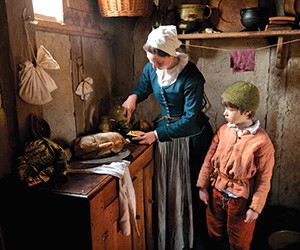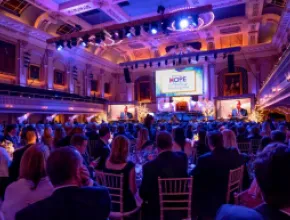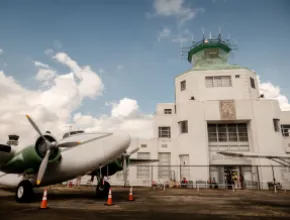Decorating a mundane ballroom with a historical theme is a daunting and expensive task that can bust a budget quickly.
What’s the alternative?
A living history museum.
These portrayals of history come to life—which typically incorporate authentic or re-created buildings and settings accented by actors in detailed period costumes—can excite, inspire and motivate attendees.
“An historical setting can elicit lots of emotion and create an excitement about a program that you can’t find at more-traditional venues,” says Liz Barron, senior director of executive education for the Robert H. Smith School of Business at the University of Maryland.
Battle Tested
Barron stages leadership programs at Pennsylvania’s Gettysburg National Military Park for executive MBA students, alumni and corporate group clients such as Lockheed-Martin and CSX. Amid cannons and monuments, Barron and her groups examine the leadership styles and decisions of the generals in the Battle of Gettysburg.
To become fully immersed in the living history aspect of Gettysburg National Military Park, the annual reenactment of the Battle of Gettysburg is popular with all types of groups. The four-day event in July encompasses soldiers in Civil War uniforms, battle reenactments, a living history village, field demonstrations and guest speakers.
Pilgrim Pride
Celebrating an earlier stage in American history is Plimoth Plantation in Plymouth, Mass., which immerses visitors in an experiential outdoor and indoor living history environment.
The main attractions at Plimoth Plantation are a re-created 17th century English Village, a Native American homesite, actors in period costumes and the Mayflower II, a full-scale replica of the original Mayflower.
“The group possibilities include guided tours, dinner events, cocktail parties and small meetings,” says Diane Cox, Plimoth Plantation’s catering sales manager.
A popular group event is the Harvest Dinner, which features pewter plates, period cuisine like roast pork and cucumber and asparagus salad, and a Pilgrim sing-a-long.
Cox says guest speakers in period attire can tailor their performance to relate 17th century practices to modern-day methods in medicine, banking, real estate and a variety of other topics appealing to corporate and association groups.PageBreak
Colonial Times
Perhaps the most well-known living history museum in the U.S. is Colonial Williamsburg in Virginia.
“Most people who’ve not visited us have some vision of Colonial Williamsburg, but when they see the extent of the authenticity in costumes, the attention to detail on our buildings and the street theater they’re blown away,” says Perry Goodbar, vice president of sales and business development at the Colonial Williamsburg Foundation.
The “Revolutionary City” places visitors in 18th century life surrounded by government buildings, homes, gardens, shops and taverns—plus actors dressed as townspeople, shopkeepers and political figures.
Goodbar says one of the most appealing aspects to groups of “The Revolutionary City” is its locale just one block away from three hotels that can host meeting groups: the 323-room Williamsburg Lodge with 45,000 square feet of meeting space; 300-room Williamsburg Woodlands with 13,000 square feet of meeting space; and the 62-room Williamsburg Inn with 9,000 square feet of meeting space.
“The convenient location makes it easy for attendees to stroll over for an hour or two, during free time in the afternoon after morning meetings or for spouse programs that don’t require transportation,” Goodbar says.
Ozark Traditions
For a hands-on living history experience, the Ozark Folk Center in Mountain View, Ark., offers private demonstrations and workshops highlighting a variety of Ozark mountain skills.
Attendees can learn about things like basket weaving, blacksmithing, woodcarving, soap-, doll- and candle-making, and several other crafts and skills.
“It’s a great way to get people involved and a nice reprieve from intense meetings,” says Jeanette Larson, craft director at the Ozark Folk Center.
Popular group activities include Ozark-style music concerts with sing-a-longs, outdoor cookouts and Southern cooking dinners at the Skillet Restaurant.
The Ozark Folk Center has 66 resort-style cabins on-site, 1,000-seat and 200-seat auditoriums, seven classrooms that can accommodate up to 10 people each, and the Bois d’ Arc Center, a private meeting area with capacity for up to 150 people.
Wild Wild West
Capitalizing on Americans’ timeless love affair with cowboys, Old Tucson in Tucson, Ariz., is a combination movie studio, theme park and living museum.
More than 300 Western movies have been filmed at Old Tucson, including classics like Gunfight at the O.K. Corral, Rio Bravo and Tombstone. Popular television shows like The High Chaparral and Little House on the Prairie also used the set.
“Groups get excited quickly with our gate greet, where gunslingers fire guns [with blanks] in the air and get everyone in a rollicking mood,” says Reini Marsh, general sales manager at Old Tucson Company.
Available for buyouts, Old Tucson can accommodate groups of up to 4,500 for a variety of customized events, spouse programs and team building such as roping a steer and other western activities.
An Old West town circa the1860s, Old Tucson engages attendees with gunfights, saloon musicals, stunt shows and historical studio tours.
Edward Schmidt Jr. relishes historical venues and hotels as long as Wi-Fi is readily available.






